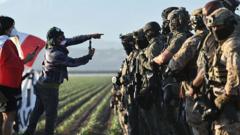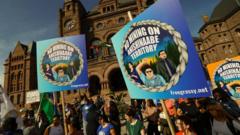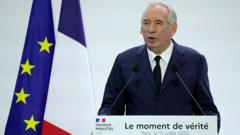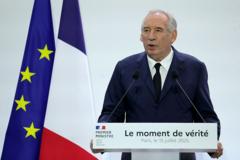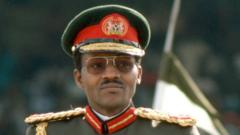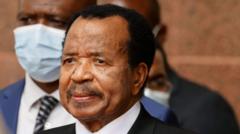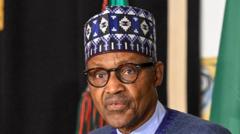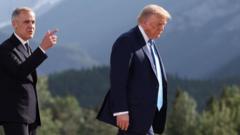The latest updates reveal the political dynamics at play as Canadians have cast their votes in a closely watched election, significantly influenced by U.S. trade tensions and leadership transitions. As ballot counting procedures commence, both major parties grapple with their positions on crucial issues.
**Canada's Crucial Federal Election Pivots Amid Global Tensions**

**Canada's Crucial Federal Election Pivots Amid Global Tensions**
As polls close in Canada, a pivotal federal election unfolds, challenging the political landscape with Mark Carney of the Liberal Party emerging as a frontrunner against Pierre Poilievre of the Conservatives, amid a backdrop of international pressures.
In a decisive election for Canada, the citizens head to the polls to select their parliamentary representatives under a veil of unprecedented external pressures, with results anticipated to reshape the nation's leadership. The political scene has shifted dramatically, with Mark Carney, newly positioned as the Liberal leader, gaining momentum against Pierre Poilievre, who previously led in polls by a substantial margin prior to the election season.
Just three months prior, the Conservative Party seemed poised for success amid Justin Trudeau's declining popularity. However, Carney's leadership transition alongside the imposition of tariffs by President Trump has reinvigorated public support for the Liberals, suggesting a potential reversal in fortunes at the polls. Alongside these two, smaller parties including the New Democratic Party and the Bloc Québécois vie for minimal representation in a race refocused on economic resilience and international relations.
Poll closures are staggered, contributing to a rush of reporting as ballot counting begins with an expected focus on regions in Newfoundland and Labrador. Unlike automated systems, Canadian elections are reliant on hand-counted paper ballots managed by Elections Canada personnel. This traditional method allows for detailed oversight but also extends the timeline for complete results.
Pre-election sentiment indicated a lower emphasis on climate change and immigration, traditionally pressing topics, as Canadians navigate the electoral landscape shaped by economic considerations under the looming threat of U.S. policies. Opposition leaders' contrasting approaches highlight fundamental national priorities as they confront external adversities, particularly strategies directed at safeguarding Canada's sovereignty amidst escalating trade battles.
As both major parties position themselves for the final stretch, public discourse remains focused on viable economic strategies, with Carney appealing as a calculated negotiator capable of addressing the impactful decisions of the current U.S. administration. Voter turnout during advance polls signals engaged participation, setting the stage for pivotal election results that could change the narrative of Canadian politics in dire economic times.
With many at the polling stations, including individuals representing diverse backgrounds and sentiments about the election's stakes, the unfolding results may usher in a new chapter in Canada’s governance, reinforcing or reshaping its relationship with the United States as the nation contends with a tumultuous international environment.
Just three months prior, the Conservative Party seemed poised for success amid Justin Trudeau's declining popularity. However, Carney's leadership transition alongside the imposition of tariffs by President Trump has reinvigorated public support for the Liberals, suggesting a potential reversal in fortunes at the polls. Alongside these two, smaller parties including the New Democratic Party and the Bloc Québécois vie for minimal representation in a race refocused on economic resilience and international relations.
Poll closures are staggered, contributing to a rush of reporting as ballot counting begins with an expected focus on regions in Newfoundland and Labrador. Unlike automated systems, Canadian elections are reliant on hand-counted paper ballots managed by Elections Canada personnel. This traditional method allows for detailed oversight but also extends the timeline for complete results.
Pre-election sentiment indicated a lower emphasis on climate change and immigration, traditionally pressing topics, as Canadians navigate the electoral landscape shaped by economic considerations under the looming threat of U.S. policies. Opposition leaders' contrasting approaches highlight fundamental national priorities as they confront external adversities, particularly strategies directed at safeguarding Canada's sovereignty amidst escalating trade battles.
As both major parties position themselves for the final stretch, public discourse remains focused on viable economic strategies, with Carney appealing as a calculated negotiator capable of addressing the impactful decisions of the current U.S. administration. Voter turnout during advance polls signals engaged participation, setting the stage for pivotal election results that could change the narrative of Canadian politics in dire economic times.
With many at the polling stations, including individuals representing diverse backgrounds and sentiments about the election's stakes, the unfolding results may usher in a new chapter in Canada’s governance, reinforcing or reshaping its relationship with the United States as the nation contends with a tumultuous international environment.

